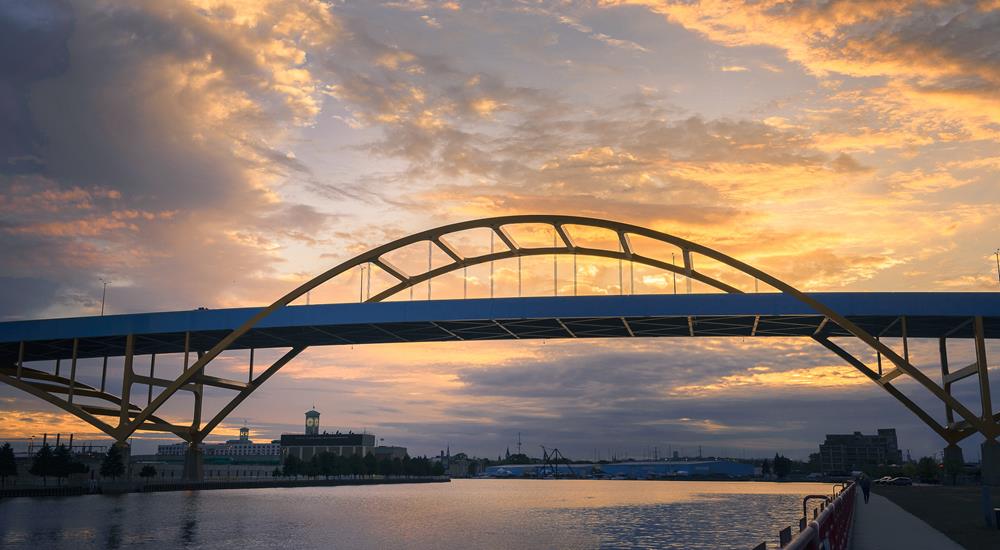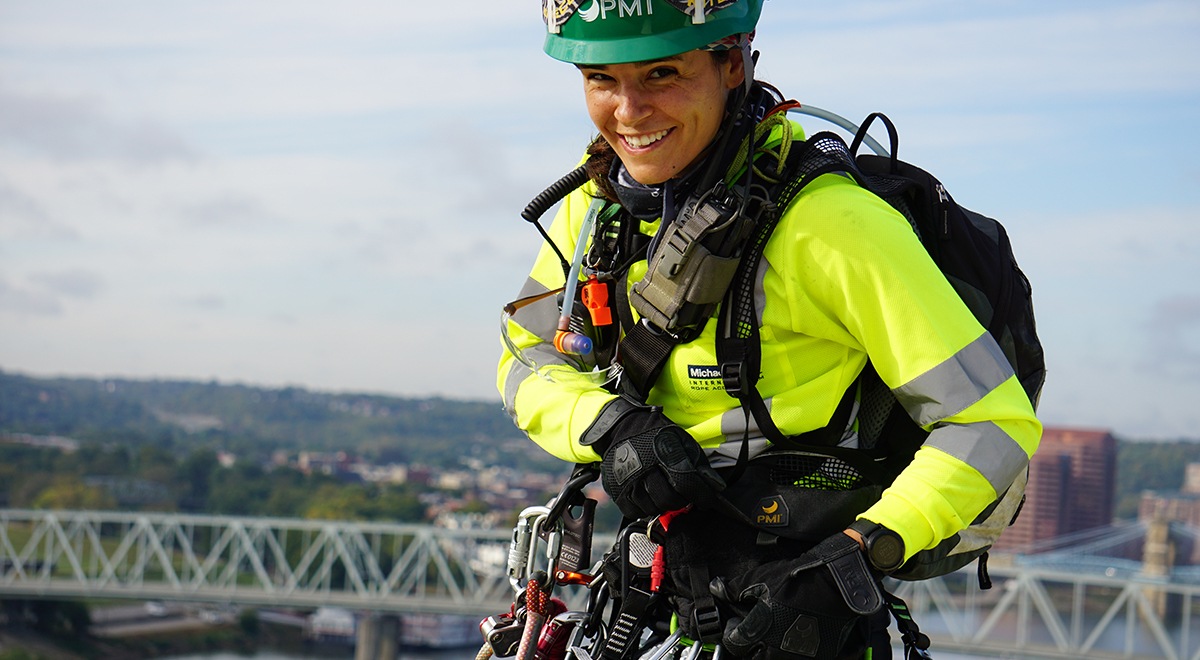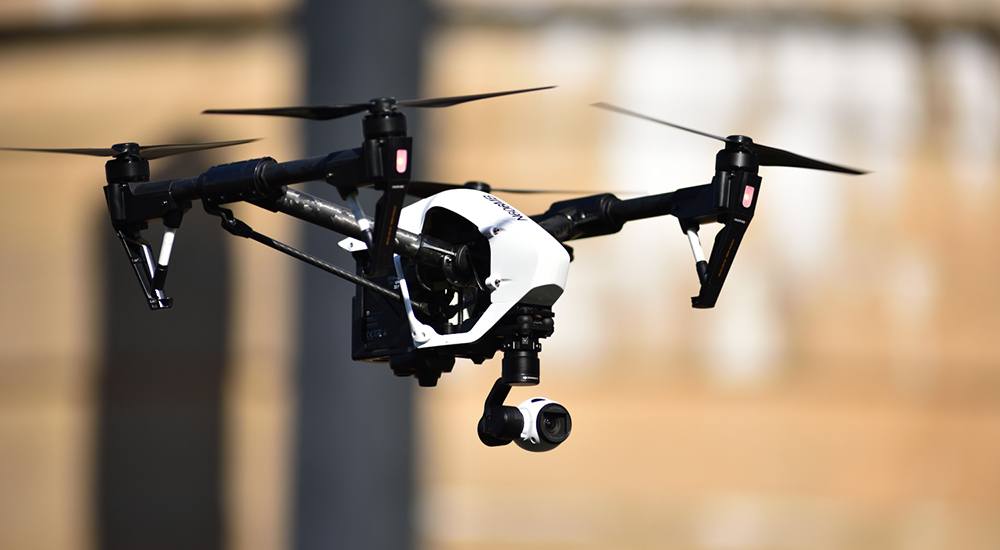Michael Baker balances innovation, stakeholder coordination to rehabilitate Milwaukee’s iconic Hoan Bridge
From the Fall 2016 issue of Signature
Milwaukee’s iconic, picture-perfect Daniel Hoan Bridge not only connects the Port of Milwaukee with interstate 794, it also serves as a primary commuter route into the city for 42,000 vehicles a day. The bridge is a dramatic gateway to Milwaukee’s historic Third Ward and Maier Festival Park – home to Summerfest and ethnic festivals drawing more than 1 million visitors annually.
The Hoan Bridge served the city well for most of its 40 years. However, four decades of steady traffic and changing weather took their toll, leaving the two-mile-long bridge and adjacent roadway badly deteriorated and in dire need of rehabilitation.
So how would the Wisconsin Department of Transportation (WisDOT) replace 34,000 cubic yards of deck concrete, install 11 million pounds of deck-reinforcing steel and repaint 1.5 million square feet of bridge infrastructure without virtually shutting down the city and its nearby shipping port in the process?
WisDOT in 2011 ultimately turned to a team of surface transportation engineers from Michael Baker International in Wisconsin, in partnership with engineering firm GRAEF, a sub-consultant, to address those issues and help lead this complex project. The Michael Baker team served as the lead engineering consultant on what would become a $193 million construction project for the region.
The project, which began in 2011, was completed in December 2015.
“The Hoan Bridge is an iconic structure that plays an important role in the region’s transportation infrastructure, and our team knew we would need to bring the company’s full continuum of innovative solutions to bear on this project,” says Kent Zinn, vice president and office executive for Michael Baker’s Wisconsin operations. “We delivered on that challenge by minimizing disruptions during construction and introducing engineering innovations that can stand the test of time.”
Such issues didn’t go unnoticed. The project recently earned Michael Baker the “Best of the State Award for Structural Systems” from the American Council of Engineering Companies Wisconsin for the team’s work on the bridge and roadway project, and a 2016 “Excellence in Highway Design Award for Consultant Structure Design” from WisDOT for the project.
Other awards include: ACI Notable Projects of Milwaukee; and Daily Reporter - Top projects of 2015.
“We’re honored by the accolades,” Zinn says.
CHALLENGES FROM THE START
For those involved with the project, though, December 2015 likely seemed a distant aspiration, given the many challenges that had to be addressed throughout the life of the project.
The Hoan Bridge, built originally in the mid-1970s, provides a key link in southeast Wisconsin’s transportation network by connecting I-794 in downtown Milwaukee to the Lake Freeway across the Milwaukee River. Following repairs for a past major failure and multiple previous rehabilitation projects, the Michael Baker team had to quickly develop a long-term solution to keep this critical route open for business, according to Chad Halverson, PE, who served as the deputy project manager for Michael Baker on the project.
“The Hoan Bridge is a complex steel structure made up of nearly 50 individual units, including a steel-tied arch, post-tensioned box girders, steel plate girder and girder-stringer-floor beam spans,” says Halverson of the complexity of the original design.
Moreover, the bridge crosses 120 feet over the Milwaukee River Harbor inlet, where large cargo ships traverse frequently. And it spans the Milwaukee Metropolitan Sewage District (MMSD) and port terminal, which includes several railroad lines as well as significant crane activity to load and unload freight. The Michael Baker-led project team had to coordinate
with the port, its tenants, MMSD and even the U.S. Coast Guard to establish a staged-construction approach to the work to minimize disruptions as sub-contractors attempted to safely and efficiently execute the work.
“Though the project was daunting with multiple stakeholders involved, the team handled it professionally and efficiently,” says Brian Kasprzyk, field engineer with the Port of Milwaukee. “They were very receptive to our needs at the port. We appreciate the team’s effort in successfully completing this massive project with minimal disruption to daily operations at the Port of Milwaukee.”
BRIDGING STAKEHOLDER INTERESTS
Coordination with stakeholders during the design process also contributed to helping construction proceed smoothly, Halverson says. Members of the project team conducted more than 80 stakeholder meetings during the planning process to discuss elements ranging from construction impacts to project aesthetics.
Proactive coordination, for instance, allowed the Milwaukee Public Market, a unique year-round indoor specialty food market located under the east-west structures, to maintain parking and remain open for business throughout the duration of construction. The festival grounds, located directly adjacent to a portion of the bridge, represented the biggest coordination challenge, Halverson suggests, in terms of both design and construction since the site’s many festivals throughout the year attract more than a million visitors.
The Milwaukee County Transit System (MCTS) and Wisconsin Coach, which provide for festival attendees non-stop access to and from the grounds, required additional coordination to identify viable detour routes to ensure unimpeded operations. Major demolition also required extensive stakeholder coordination.
The project, which encompassed nearly 100 structure units (equivalent to 18.5 lane miles), involved substantial repairs on numerous structures and structure types, so time-sensitive and precision advanced planning, while a major challenge, became critical. The Michael Baker-led team delivered the preliminary and final designs of this major rehabilitation project in only 17 months, versus typical delivery time for this scale of project of two to three years. This included more than 3,200 final design drawing sheets completed in only nine months.
WASTEWATER CONSIDERATIONS
Given the proximity of the bridge to the MMSD’s Jones Island Water Reclamation Facility, the Michael Baker team also had to navigate the potential for problems at the facility caused by demolition, construction, stormwater design, painting and other challenges. The team found success there as well.
“The Hoan Bridge project had significant potential to impact operations on the Milwaukee Metropolitan Sewerage District’s Jones Island Water Reclamation Facility and sanitary sewers,” notes Debra Jenson of the MMSD. “Early in the planning process, Wisconsin’s Department of Transportation recognized the issues and proactively worked with MMSD to make sure our efforts to protect public health were not adversely impacted, especially since the Jones Island facility sits directly under the Hoan Bridge.”
By working together, the project team minimized impacts to:
- Wastewater treatment at Jones Island, Wisconsin’s largest water reclamation facility.
- Worker protection from falling construction debris and paint overspray.
- Wastewater from storm sewer cleaning on the bridge, discharging it into MMSD’s sewers to be cleaned at the district’s treatment facilities and therefore protecting area waterways.
- Maintenance equipment access by designing special access paths to MMSD facilities that supported the equipment.
- Truck traffic ability to reach Jones Island during construction
INNOVATION APPLIED
To successfully reconstruct the bridge, the project team challenged itself and its stakeholders to create a plan that balanced the project needs with stakeholder concerns. To do so, the project incorporated several technical and material innovations, including the following:
- Movable concrete barriers (MCB) – In its inaugural use in Milwaukee, this approach maintained two peak direction lanes in the peak periods. MCB minimized impacts to the traveling public during peak rush-hour traffic volumes by allowing the number of traffic lanes to be adjusted to match daily traffic patterns, reducing user delays and impacts as well as the potential for crashes and injuries.
- Staged-construction approach – The staging was critical to meet the project’s aggressive schedule and received enthusiastic public acceptance. The use of MCB minimized the projected peak-hour delays and queue lengths. These reductions were critical given the two-year construction time frame for the project and the need to maximize access to the many lakefront events.
- Stainless steel reinforcement – A Wisconsin first for a project of this size, 11 million pounds of stainless steel reinforcement were used in the new decks, to effect lower future maintenance costs, a longer deck life and lower life-cycle costs. Most bridge decks include epoxy-coated steel reinforcing bars to resist corrosion introduced by chloride ions from de-icing chemicals. Although stainless steel reinforcement has a higher initial cost than epoxy-coated reinforcement, recent studies have shown that it provides more consistent resistance to corrosion by virtue of the metallurgic structure of the steel.
- Light Detection & Ranging (LiDAR) – Used to collect and process bridge component data, this geospatial information technology better defined the scope of needed repairs while minimizing traffic disruption and saving time and money.
“Through the use of multiple structural engineering technologies and techniques, this project captures the spirit of engineering innovation,” says Terry Bay, an awards judge with the American Council of Engineering Companies Wisconsin, upon Michael Baker’s winning of the “Best of State Award” for the bridge project. “The project stands out because of its complexities in project construction and its dynamic approach to maintaining the accessibility of a major transportation link.
GIVING BACK TO MILWAUKEE
In addition to the planning, design and construction innovations, the project also included the incorporation of innovative stormwater quality best management practices for the removal of pollutants from highway runoff. As part of that effort, the new designs called for the rehabilitation of existing stormwater treatment units and added more than 100 enhanced catch basins.
Additionally, the team worked with the City of Milwaukee and the Historic Third Ward Association to provide bridge and wall aesthetics, landscaping and decorative street lighting. The project also included construction of a raised-platform stage, amphitheater seating, landscaped retaining walls, programmable lawn space, plantings, connections to the Milwaukee River Walk and a central sculpture garden.
Overall, the project: mitigated safety concerns; reduced congestion; improved emergency response time and travel reliability; supported freight and commerce throughout the process; and expanded public transit access.
“We had been working as a consultant with the Wisconsin Department of Transportation for fewer than 10 years, so this project says a lot about the kind of reputation we have built there in a very short time,” says John Dietrick, highway and bridge regional practice lead at Michael Baker. “This was a real success for us.”




